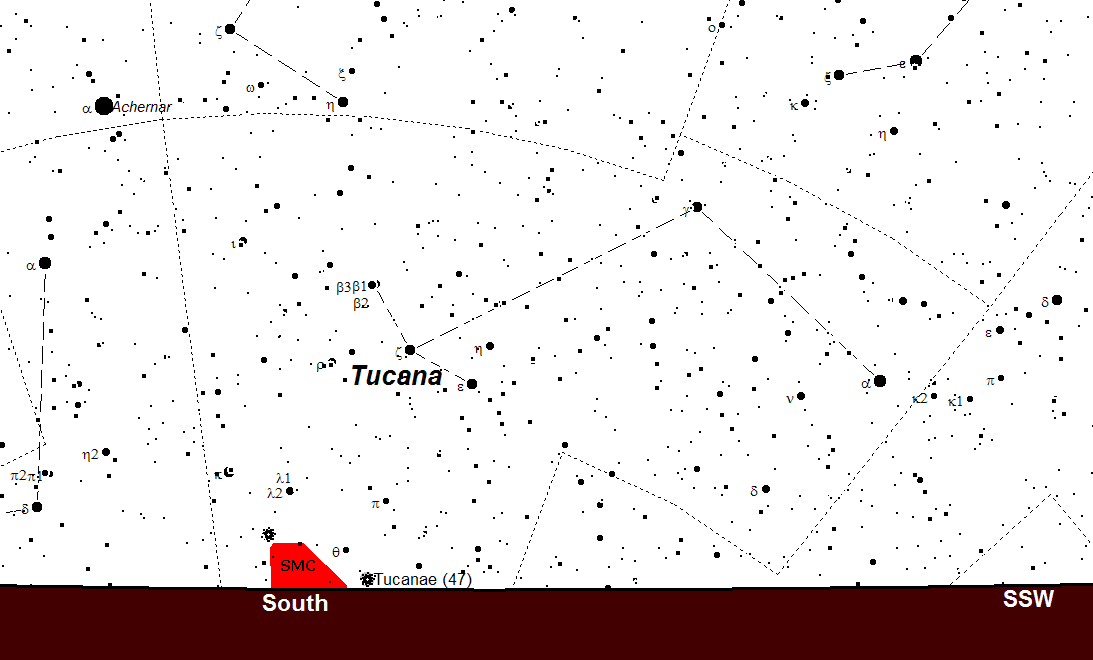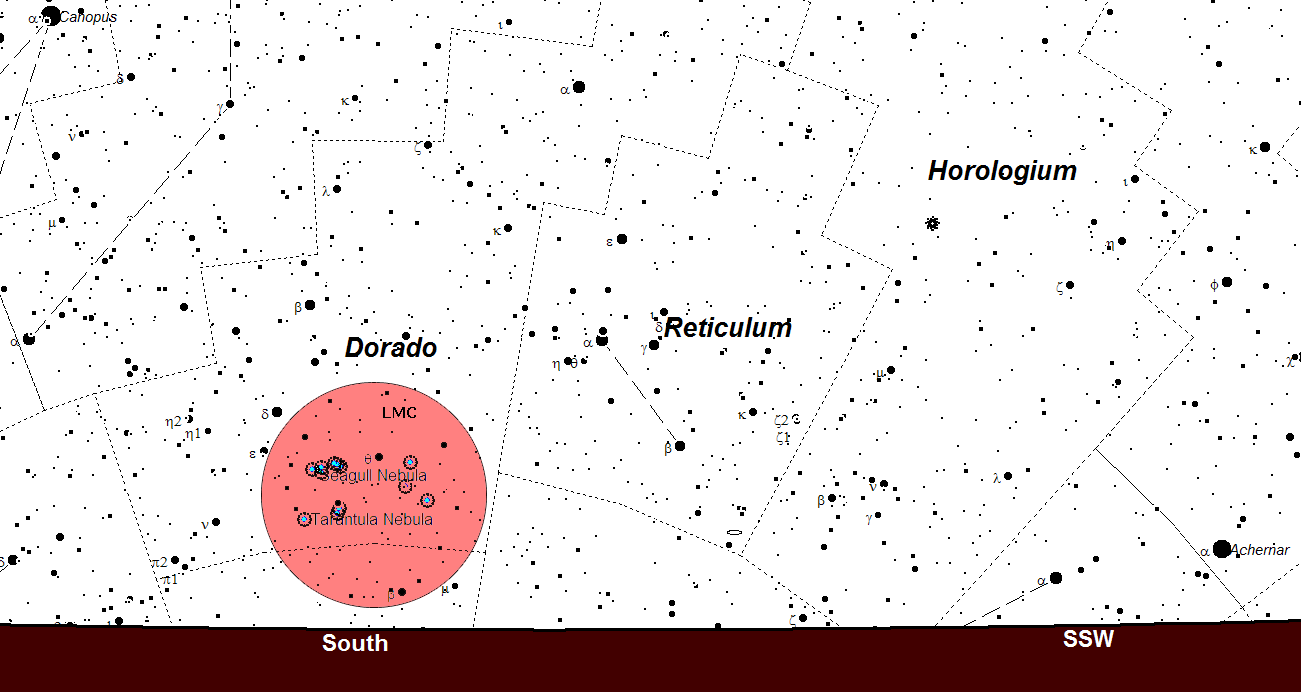

I spent Christmas in Belize. Formerly known as the “British Honduras,” it is one of the northernmost countries in Central America, it is well known for scuba diving and Mayan ruins. I could go on, but I want to talk about something else; the Magellanic Clouds.
I was hoping to get a chance to observe the Magellanic Clouds while in Belize.
What are the Magellanic Clouds? In 1519, Ferdinand Magellan attempted to find a route from Spain to the Spice Islands; in the process his expedition circumnavigated the earth (though Magellan himself was killed before the ships returned home). Some crew members on Magellan’s ship noticed two fuzzy cloud-like patches in the night sky. They are not visible from Europe, but people living in the Southern Hemisphere must have seen them, but until Magellan, little had been written about them. We now know these fuzzy patches are galaxies, the larger is known as the Large Magellanic Cloud (LMC) and the smaller is known as the Small Magellanic Cloud (SMC).
The Magellanic Clouds are not visible from North America either (except for the extreme southern part of Mexico), but they are visible from Central America provided you observe at the right time, you have a decent horizon and there are no clouds blocking the southern sky. (You may see statements that the Magellanic Clouds are only visible from the southern hemisphere, that isn’t true. Belize and rest of Central America are north of the equator).
This was not my first trip to Central America. Five years ago, I took a trip through Costa Rica. We stayed at different locations in the country, spending a couple days in one location, three days in a different location and so on. I had attempted to observe the Magellanic Clouds on that trip, however each evening, it was either overcast or I did not have a good south horizon. I hoped to have another attempt some day.
Now was the time for a second attempt. Before I left for Belize, I looked at some star charts. The Magellanic Clouds would be close to the horizon; when objects are close to the horizon, it is best to observe them when they are as far above the horizon as possible. That happens at transit.
I used The Sky astronomy program to determine the transit times. First I had to set the location. Apparently by default, The Sky only shows U. S. cities, so I had to first switch to cities “Outside USA.” That list included “Belize City” which was close enough. I set the date to December 20, 2006, and set the Daylight Saving Adjustment Option to “Not Observed.” (Had I forget this last step, my times would have been off by one hour).
I then used the Find object feature and searched for “SMC”. It gave the following information
Rise: 18:04 Transit: 18:48 Set: 19:32
Thus suggests I should look due south at 6:48 PM (give or take about 40 minutes; The transit times change slightly from day to day, but it’s only a few minutes a days). Even at transit, the SMC would be partly below the horizon. Sunset would be at 5:23 PM. In the tropics the transition from daytime to darkness is faster than in Michigan, and it should be quite dark by 6:48.
I made a chart. In chart mode, the SMC was not marked, so marked its location by hand. (The marking is only a rough indication of size and shape).

(You may need to scroll to the right to see the entire chart).
I then used Find object and searched for “LMC”. It gave the following information.
Rise: 20:37 Transit: 23:15 Set: 01:57
Ideally I should look due south at 11:15 PM (however there is a window of several hours during which it should be visible). At transit, it would be a few degrees above the horizon, low but higher than the SMC. It is also larger and brighter than the SMC and visible for a longer time. Thus the LMC should be easier to see. Again I made a chart, on this one I added a circle representing the approximate shape and location of the LMC.

(You may need to scroll to the right to see the entire chart).
I expected that the sky would somewhat different than what I am used to. While some familar constellations, like Orion, would be visible; others like Ursa Major would not be. You cannot use the big dipper to figure out which way is North (at least not on a winter evening). However there are other ways to determine directions.
When I arrived in Belize, I took a boat to the place where I would stayed over the next week, a caye about 10 miles from Belize City (a caye, pronounced “key,” is a small island). The south horizon was almost perfect. There was a beach where I could look out onto the Caribbean Sea. There was another caye directly south. It was some distance away and didn’t have much elevation—it shouldn’t block much.
I had not brought a telescope, but I had a pair of 7x50 binoculars.
The caye had a number of houses and a few house lights. To the north, there was a visible glow. That was Belize City. In addition to the lighting you’d expect from a city of 60,000 residents plus a variable number of tourists, the city had one obnoxious bank of bright lights. I could not identify what it was, but it reminded me of some of the obnoxious lighting near Ann Arbor. In addition, ships occasionally were anchored near the caye and they had lights. Otherwise it was quite dark, especially to the south.
This was the tropics and it was warm, I didn’t need a heavy winter jacket and long underwear (both are needed to observe on the coldest winter nights in Michigan).
The first few nights were cloudy. However there were some clear nights. Even so, for some reason there always seemed to be a cloud bank which covered the southern horizon shortly after sunset, and I never was able to see the SMC.
The LMC was a different story. The clouds cleared up on few nights. On one of the clear nights, I saw a fuzzy spot to the south. I wasn’t sure, so I used the binoculars. It was the LMC. It is slightly too big to fit in the field of view of 7x50 binoculars and is an impressive sight.
There are a number of interesting objects located within the LMC; most notably NGC 2070 (also known as the Tarantula Nebula) and the remnant of Supernova 1987A. Only some of the objects are visible in binoculars.
The SMC has its own collection of objects. I won’t mention any of them, but I will mention a nearby object. 47 Tucanae, also known as NGC 104 (it is marked in the chart just west of the SMC). This is a globular cluster, the second brightest in the sky, second only to Omega Centauri.
In theory it should be possible to see both the SMC and 47 Tucanae from Belize, but just barely. A location further south would be better. Not only would it make all the southern objects easier to see, but it gives you a chance to look for the south pole. There is no bright star anywhere near the south celestial pole—you can use the LMC and SMC to determine the pole location; but that is only possible if both are visible in the sky at the same time. For that you need to be south of the equator. Perhaps some day I’ll have a chance to do that.